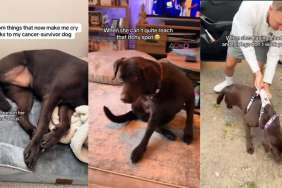Few words in the English language cause the instant dread of the word cancer. In dogs, cancer is the leading cause of death, and it’s all the more heartbreaking because it remains a complex disease for which we often have little or no insight into the cause. In a time of huge leaps forward in cancer treatment, one reason cancer prevails as the leading cause of death is perhaps a surprising one: Because our dogs are so much better cared for today, they are living longer. Older dogs become more susceptible to such diseases of old age as tumors.
But just as the outlook has brightened for humans, so too is treatment of canine cancer reaching a phase in which management and even cures may be possible if your dog is diagnosed early.
Is it really cancer?
The term tumor applies to any lump, bump, or growth. It can also include a swelling created by an abscess or similar problem. Tumors fall into two categories: benign and malignant.- Benign tumors are not cancerous. They grow slowly and don’t invade neighboring tissue. They do not spread to other parts of the body, and they can often be removed through surgery.
- Malignant tumors (also called carcinomas, sarcomas, or lymphomas, depending on the tissue where they originate) are cancers that invade surrounding tissue. A malignant tumor, if untreated, will eventually metastasize, meaning it enters the lymphatic system or the bloodstream and spreads to other parts of the body.
When it’s time to see a vet
Cancer is most common in dogs middle-aged and older, but it can occur at any age. Luckily, about half of all cancers can be detected through physical examination. Others, such as those in the spleen or liver, show no signs early on and can therefore be quite advanced by the time they’re detected. Since time can be of the essence, it’s important to see a vet at the first sign of any physical change. Signs to watch for include:- Sores on or beneath the skin
- Appearance of a lump or lumps anywhere on the body
- A swollen limb, or swelling on a bone
- Loss of appetite
- Persistent cough
- Labored breathing
- Difficulty eating or swallowing
- Difficulty urinating or defecating
- Weakness
- Increased thirst and/or more frequent urination
- Bleeding or discharge from any body opening
- Change in size of one or both testicles
What’s next
To diagnose a tumor, the vet must take a biopsy so cells can be examined under a microscope. If the diagnosis is cancer, your vet will be able to explain to you how advanced it is and what your treatment options are. If detected early, there may be a good chance of a successful outcome. Treatment for cancer can involve many options, all of which have both an emotional and a financial impact. You need to consider:- Effectiveness of treatment and likely outcomes
- Health of your dog and prognoses with and without treatment
- Age of your dog and likely quality of life during and after treatment
- Cost. A deep tumor removal may cost more than $1,500. Radiation therapy may cost $2,000 to $6,000.
Difficult decisions
The care and treatment of a beloved pet is a personal decision for every dog owner. You should discuss options and outcomes with your vet before deciding how to treat–or not treat–cancer in your dog. It’s important to have reasonable expectations, which are frankly difficult to achieve when you’re dealing with a good friend. In some cases, it may be that treatment will not prolong a dog’s life. We’ve all heard stories of an owner treating a 16-year-old dog with cancer with radiation therapy, and we’ve thought, “I’d never do that.” But letting go can be incredibly difficult when it comes to your own dog. Be honest with your veterinarian, and consider what’s best for a loving pet who has been a faithful and longtime companion. Sometimes euthanasia can be the most humane option, and the final act of respect for a beloved dog.Types of treatments
If cancer’s detected early and the tumor is still small, odds are your vet will recommend that it be removed surgically. This involves removing not only the tumor but also a margin of surrounding skin, to make a recurrence less likely. If the cancer has spread to surrounding lymph nodes, successful removal of all of the affected nodes and the tumor can result in a cure. If it has spread further, surgery is unlikely to remove all of the cancer. But removing the primary site may still provide relief and improve the dog’s quality of life. Often, treatment can put a cancer into a partial or total remission–meaning a decrease in the size of a tumor, or that there is no cancer still detectable in the body. Remission does not necessarily mean cured. Often, remission is a state, and there is a likelihood of eventual return. While remission times have increased with better treatment, for many types of cancer the eventual return is inevitable. Some advanced treatments of cancer include:- Radiation therapy. If a cancer has not metastasized, radiation therapy can be an effective treatment, since many tumors in dogs are sensitive to X-rays. It’s unlikely that your vet will have the equipment to perform radiation therapy–you’ll likely be sent to another facility that is equipped to provide treatment.
- Chemotherapy. With the exception of transmissible venereal tumors, most canine cancers do not respond well to chemotherapy, and the treatment also causes major side effects in dogs. It usually will not extend life, although there are exceptions (in cases of lymphosarcoma and leukemia, chemotherapy can put the disease into remission). How long remission lasts is dependent on many factors, but an average length, if the dog responds well, is about 12 months.
- Immunotherapy. This treatment uses drugs such as interferon to stimulate the dog’s immune system. It shows promise of having a significant positive impact on canine cancer treatment, and it has improved survival time in some late-stage cancers, such as mast-cell tumors.
- Combination therapy. The best outcomes often come from a combination of treatments, such as surgery to remove a tumor followed by radiation therapy or chemotherapy.









